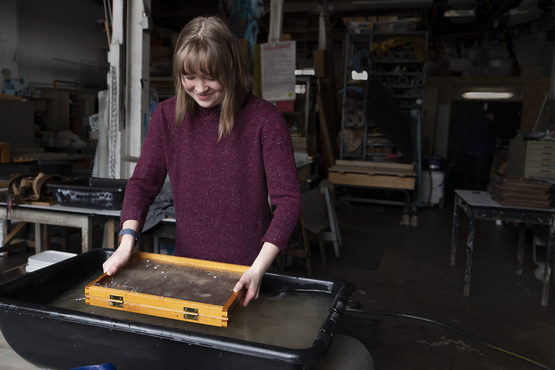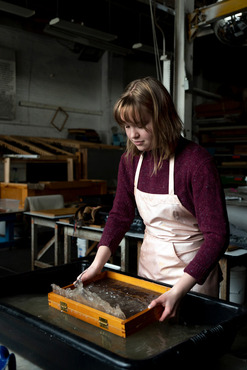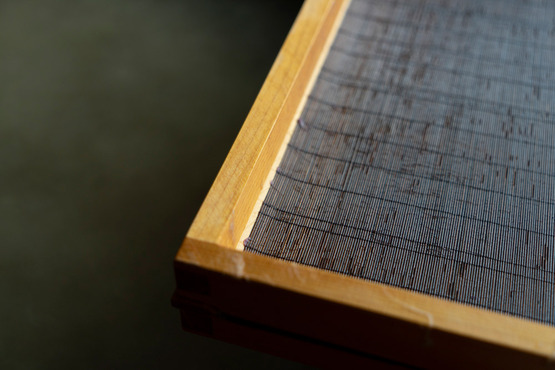
News . Feature Stories . CIA senior awarded prize to create artists books
News
March 28, 2019
CIA senior awarded prize to create artists books
Leah Trznadel on bookmaking, photography, and her senior year

Leah Trznadel at work in the paper studio at the Morgan Conservatory. Photos by Emily Flory '19, a CIA Photography + Video student.
By Jessica Moore
Leah Trznadel loves an excuse to explore new materials, so it’s no surprise that the photography student entered a bookmaking competition last fall—and won. She was one of two recipients to receive a $3,000 award from the Rowfant Club of Cleveland, one of the oldest bibliophilic societies in the United States, in its inaugural competition for creative book-related projects.
“What really drew me in was their appreciation of the physical nature of books because most of the time books are seen for their content,” Trznadel says. “I think the binding and presentation speak as much to a book as its content.”
As part of her winning submission, the CIA senior is working on an edition of artists books that examine the fragility of human experience and how the human spirit reacts to the confines of an urban landscape. The books will include poems and cyanotype images of urban and natural landscapes printed onto paper she’s making by hand at the Morgan Conservatory, a papermaking studio in Cleveland.
Trznadel brings the same passion for exploring materials to photography. She describes her BFA project as the place where cement, AstroTurf, film, and paper find common ground. “I’m always looking for a new process or material to work with and that’s always been the driving factor in my work,” she says.
Scheduled to graduate this spring, now is a busy time for Trznadel. She recently answered some questions for us about bookmaking, photography, and her career at CIA:
Congratulations on your award from the Rowfant Club! What made you want to enter?
Thank you! I love bookmaking and any excuse to explore new materials, but I don’t always have the funding. When I saw a call for entry that was seeking creative book-art projects, I thought it was the perfect opportunity to try something new and innovative.
Can you tell us about the artists books you’re creating?
I’m using the cyanotype process to print images onto handmade paper and encasing that paper in resin, so the entire book will be transparent with traces of imagery floating in the pages. From the front of each book, you’ll be able to see the entirety of the contents inside, and as you flip through, the imagery will be unpacked and simplicity will be revealed. I’m hoping the experience will be one of contemplation and meditation as the cluttered landscape becomes legible.
What made you want to become a photographer?
Photography is such an underappreciated medium. Images are so closely tied to their referents that we look straight past the image and take it for whatever’s in the frame. Take a picture of a cup of coffee, for example. If someone references it and asks what it is, it’s always “a cup of coffee” and not “a picture of a cup of coffee.” But a photograph is an object itself, and I think there’s just so much to unpack there.
When you started at CIA, did you know that you wanted to major in Photography?
Not at all. I loved photography but I saw it more as a hobby than a career. I came for interior architecture and ended up not even applying to that major. Now knowing the amount of drawing involved in that major and having been through Drawing I and II, I’m definitely glad I went with photography.
Where do you find inspiration for your work?
I find my inspiration in material. I’m always looking for a new process or material to work with and that’s always been the driving factor in my work. My practice is very hands-on and process-based. I want my work to be tactile and to convey a sense of curiosity for materiality and the physical touch.
Did you have any internships while you were a student?
Yes, I did and they were some of the best experiences I’ve had. My first internship was for an organization called Cleveland Outreach, where I took school pictures of students and created yearbooks for them. I loved it so much and had such a connection with the students that I interned with them for two years, and I still volunteer. I was also part of the internship program at the Morgan Conservatory, where I learned the process behind Eastern-style papermaking, which I’m using to make the paper for these books. I now work in the gallery there installing artwork for exhibitions.
You were on this year’s Student Independent Exhibition committee. Can you tell us about that experience?
I’ve been on the committee for two years and it’s a really intense but extremely fulfilling experience. My co-chairs and I started from scratch every year—planning dates, finding jurors, reaching out to donors, arranging catering—and it’s so rewarding to see it all come together. It’s always so much fun hanging out with the artists who jury the show. The student body picks really great artists every year and it’s nice to hear the experiences of artists working in the world and their successes and failures.
Do you know what you want to do after you graduate?
I’m applying for several residencies, so hopefully, I’ll be out in the world somewhere working on my practice uninterrupted. I also work at a papermaking studio and a letterpress studio, so I’m going to take advantage of the facilities I have and eventually apply to a graduate program.
Latest Headlines view all
-
April 02, 2024
Cleveland Institute of Art students partner with Progressive Art Collection to exhibit Ready, Set, Relay! -
March 04, 2024
Cleveland Institute of Art announces Curlee Raven Holton Inclusion Scholar Program -
November 06, 2023
Collision of art and artificial intelligence creates murky waters for artists, curators and educators
Questions?
For more information about this or other CIA news, contact us here.







Social Feed